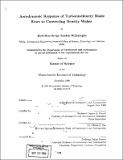Aerodynamic response of turbomachinery blade rows to convecting density wakes
Author(s)
Wijesinghe, Hettithanthrige Sanith, 1974-
DownloadFull printable version (13.50Mb)
Other Contributors
Massachusetts Institute of Technology. Dept. of Aeronautics and Astronautics.
Advisor
Eugene E. Covert.
Terms of use
Metadata
Show full item recordAbstract
Density wakes have been recently identified as a possible new source for high cycle fatigue failure in the compressor blades of modern turbomachinery. In order to characterize the density wake induced force and moment fluctuations in compressor blades a two-dimensional computational study has been conducted in viscous compressible flows with Mach numbers ranging from M[infinity], = 0.15 to M[infinity] = 0.87 and flow Reynolds number Re(c, U[infinity]) ~~700,000. Parametric tests were conducted at each flow Mach number to establish trends for the change in the maximum fluctuation of the blade force and moment coefficients with the changes in the density wake width 0.1 < w/c < 1.0 and the density ratio 0.25 < P2/P1 < 2.0. Results indicate the magnitude of the blade force and moment fluctuations to scale with (1) the non-dimensional density wake width w/c, (2) a non-dimensional density parameter p* and (3) flow Mach number M[infinity]. The viscous flow simulations have also indicated (1) periodic vortex shedding at the blade trailing edge and (2) separation bubbles on the blade suction surface which generate additional force and moment fluctuations with amplitudes ±(10 - 100%) about the time averaged mean values. These flow features represent possible additional sources for high cycle fatigue failure. Simple functional relationships have also been derived at each flow Mach number to quantify the force and moment fluctuations described above. In addition a simple cascade flow model has been developed in conjunction with the computational study to help determine the trends in the force and moment fluctuations with varying density wake properties and compressor geometries.
Description
Thesis (S.M.)--Massachusetts Institute of Technology, Dept. of Aeronautics and Astronautics, 1998. Includes bibliographical references (p. 129-131).
Date issued
1998Department
Massachusetts Institute of Technology. Department of Aeronautics and AstronauticsPublisher
Massachusetts Institute of Technology
Keywords
Aeronautics and Astronautics.